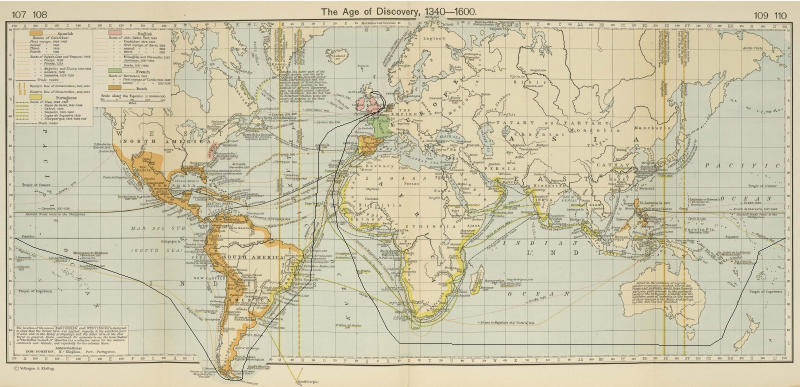(line number references are to the 1834 version of the poem unless otherwise stated).
ROUTE OF THE VOYAGE
Spectators cheer (line 21) as the ship leaves the harbour. Because the Mariner uses the Scottish word “kirk” for church (line 23), presumably the seaport is somewhere in Scotland, more easily imagined on the east coast than the west because the east coast ports would be more likely to support the provisioning requirements for such a lengthy voyage. (The Mariner also uses the word “Lavrock” for lark (1798 line 348), a word more likely to be spoken by a Scotsman than an Englishman.) The ship travels south (line 25) to the Equator (always called “the Line” in Coleridge's 1817/1834 glosses) and down past the eastern coast of South America. A storm drives the ship into Antarctic waters (line 41). After rounding Cape Horn (the southernmost tip of South America), or perhaps sailing through the Straits of Magellan, trade winds carry the ship northward (line 71) through the Pacific (line 106) to the Equator (lines 111-114), where it is becalmed (lines 115-118). The precise route of the ship for the rest of the poem is unclear, as will be discussed shortly, and has troubled many commentators. Moved by occult forces, it is presumably carried south round the Cape of Good Hope (the southern tip of Africa) and finally northward through the Atlantic again until it finally reaches its home port, where it is supernaturally sunk (line 549).
This round-the-world route was a familiar one by Coleridge’s day, and many a book had been written about such a voyage. At the time of writing the poem, Coleridge was reading many travel books describing similar journeys undertaken by adventurous mariners in the seventeenth and eighteenth centuries.
There is, however, a curious problem with the suggested route for this particular trip. By line 383, the ship has once more reached the Equator. But it was at the Equator in line 112, where it was then becalmed, but has since been sailing for some time navigated by the reanimated bodies. On the assumption that this was not just carelessness on the poet’s part, we must assume that the ship has been carried or drifted a considerable distance since it was becalmed; certainly the steersman is still at the helm in line 207 and certainly the ship continues to be driven by natural or supernatural agencies during the Mariner’s long sleep at the beginning of Part V. It might even have gone back southward into antarctic regions, thus making sense of the Mariner’s witnessing of an aurora (a polar phenomenon) in lines 313-317. It is unlikely that the ship had been carried northward, because the daemon driving the ship lives at the south pole and has no agency north of the Line (gloss to line 377).
A possible explanation is thus that the polar spirit, seeking vengeance, drags the ship southward while the Mariner sleeps, hoping to get the ship back into his home antarctic waters. The Mariner awakes and sees the aurora. The angelic troop takes command (gloss to line 377) and forces the daemon to return the ship to the Equator in mid-Atlantic in return for a promise that the Mariner has “penance more to do” (gloss to line 393), thus making sense of Coleridge’s marginal gloss to line 422, which states that the ship is miraculously carried northward immediately after the polar daemon leaves. Since the ship is then homeward bound, it must have already rounded the Cape of Good Hope, since otherwise it would have to travel south to round the Cape.
A suggested route of the voyage is shown on the following map. Click on the map for a much bigger image of it (free of the marked suggested route) or right-click to download (4.4 MB).
